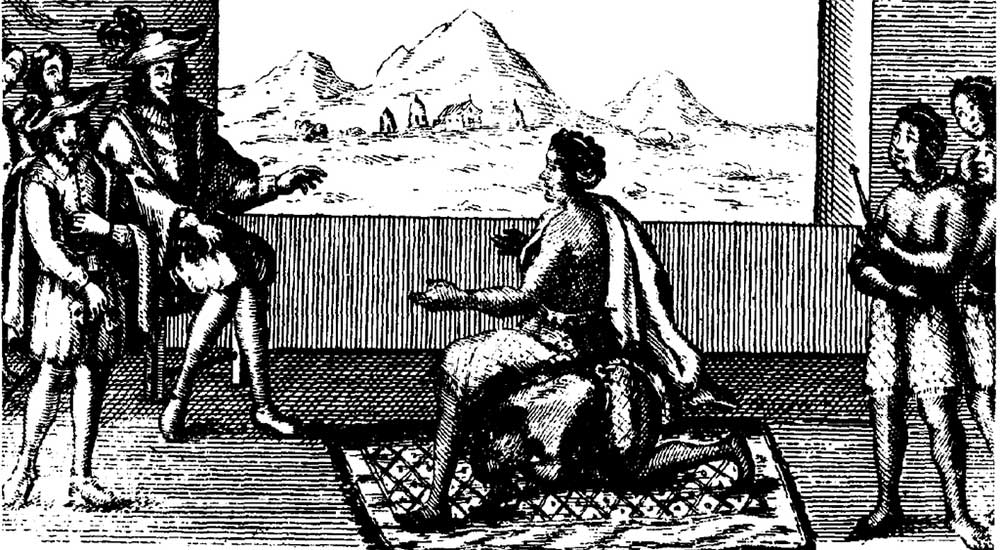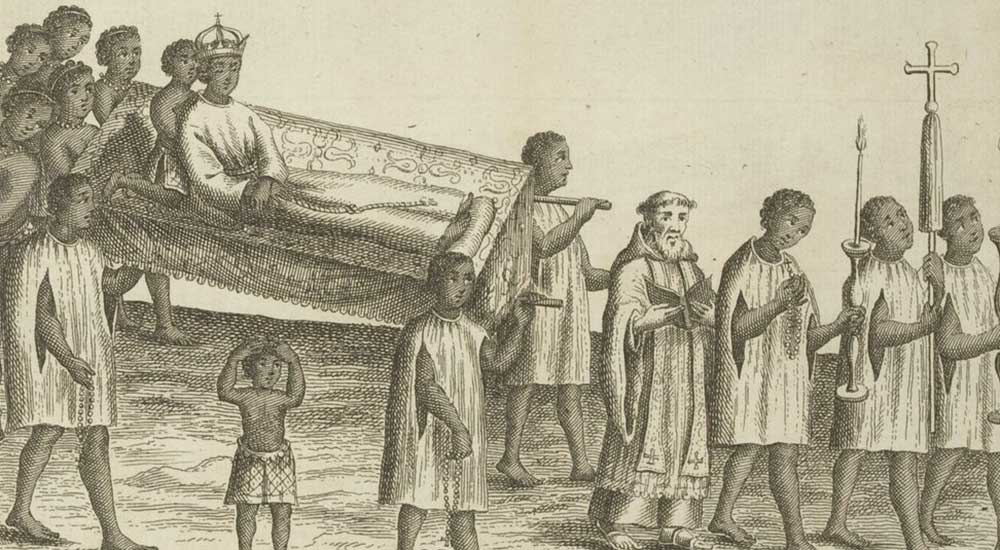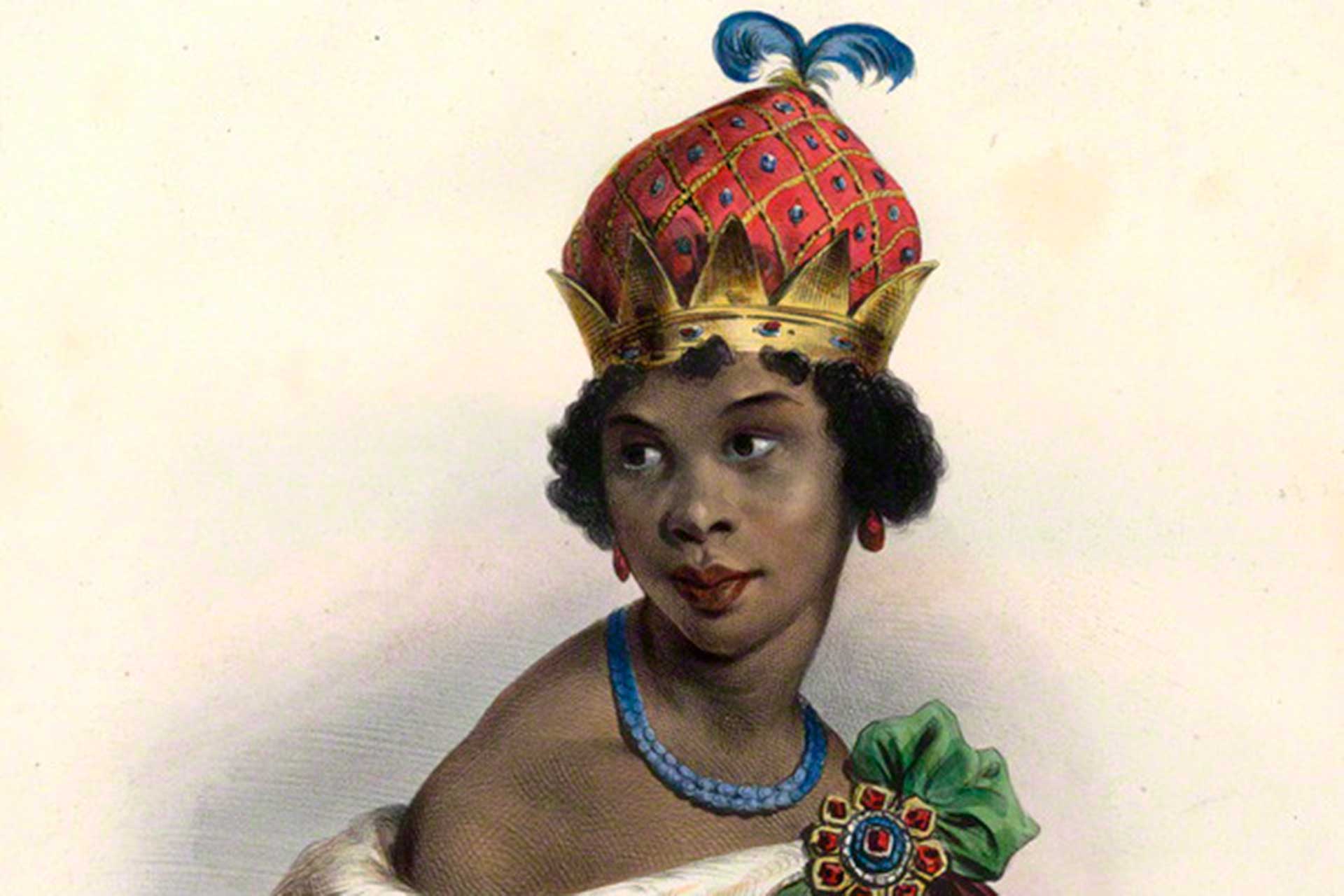Unearthing the Story of Queen Nzinga: Ndongo and Matamba’s Revered Ruler
Queen Nzinga, the revered ruler of Ndongo and Matamba, is a testament to resilient leadership during a time when colonialism sought to dominate the African continent. While her name might not be as universally recognized as some historical figures, Nzinga’s role in resisting Portuguese encroachment is a narrative both captivating and critical. This article delves into the life of Queen Nzinga, unearthing her journey from a royal sibling in the kingdom of Ndongo to a formidable leader who would challenge the might of colonial powers in defense of her people and land.
In the annals of African history, amid tales of powerful kings and fierce warriors, emerges the story of a queen whose indomitable spirit and diplomatic prowess set her apart.
Nzinga’s Early Life and Family
Nzinga was born circa 1583 in the Kingdom of Ndongo, part of the present-day Angola. From the very beginning, her life was intimately tied to the complex political dynamics of the region. The Kingdom of Ndongo was a prosperous territory, with its wealth and strategic importance catching the attention of the Portuguese, who had ambitions of expanding their colonial empire in Africa.
The daughter of King Ngola Kia Samba and his second wife Kangela, Nzinga was introduced early to the rigors of leadership and statecraft. Her father, recognizing her keen intellect and potential, ensured she received training in the military arts and in the intricacies of governance, an education usually reserved for male heirs. As a result, from a young age, Nzinga became a trusted advisor to her father, attending important meetings and even playing a role in diplomatic negotiations.

Stories from her early life hint at her fearless spirit. One such anecdote narrates how, upon her birth, Nzinga’s umbilical cord was wrapped around her neck, an omen which traditional soothsayers believed marked her as someone possessing a unique destiny. Her name, “Nzinga,” which can be translated to “to twist or turn,” is said to derive from this birth circumstance. In addition to her formidable education, Nzinga grew up witnessing the challenges her people faced, particularly from Portuguese invaders who sought to subjugate the region and control its wealth. These formative experiences would later shape her indomitable resolve in resisting colonial oppression.
Nzinga’s Ascension to the Throne of the Kingdom of Ndongo
Nzinga’s path to the throne of Ndongo was neither conventional nor without challenges. Following the death of her father, King Ngola Kia Samba, her brother, Mbandi, took over the reigns of the kingdom. His rule, however, was marred by tensions and skirmishes with the ever-encroaching Portuguese, who sought to dominate the region and exploit its resources. Mbandi struggled to handle the increasing pressures from these foreign invaders, leading to a period of instability within the kingdom.
It was during one such diplomatic meeting with the Portuguese in 1622 that Nzinga’s prowess as a negotiator became unmistakably clear. In a now-legendary episode, when the Portuguese did not offer her a seat, implying a lesser status, she had one of her attendants kneel on all fours, using him as a human stool. This act was a bold assertion of her status and equality with the Portuguese officials. Nzinga successfully negotiated the release of her brother’s son and other family members, while also advocating for the sovereignty of her people.

In a tragic turn of events, shortly after these negotiations, her brother, Mbandi, died under mysterious circumstances. Some sources suggest he took his own life, while others whisper about a possible assassination orchestrated by Nzinga herself. Whatever the cause, his demise paved the way for Nzinga to ascend to the throne in 1624. However, her ascent was not universally accepted.
Factions within the kingdom, as well as the Portuguese, sought to undermine her rule due to her gender and the controversial nature of her ascension. Yet, Nzinga, drawing upon her formidable political acumen and martial skills, managed to consolidate power, positioning herself as a beacon of resistance against foreign domination.
Queen Nzinga and her Struggle to retain Power
In the vast annals of African history, the period between 1625 to 1628 emerges as one of profound significance for the Kingdoms of Ndongo and Matamba, primarily due to the unyielding resistance of Queen Nzinga against Portuguese ambitions in the region. This period was characterized by political intrigue, fierce battles, and a desperate fight for sovereignty, with Nzinga at the helm of it all.
In 1625, tensions escalated when Portuguese soldiers were dispatched to protect Hari a Kiluanje, a soba (local chieftain) who had severed ties with Nzinga. Their involvement was a clear indication of their intentions: to create a network of alliances that could encircle and diminish Nzinga’s power. By supporting local leaders opposed to her, they aimed to weaken the unity of the region, making it more susceptible to their advances.
The year 1626 brought an overt aggression from the Portuguese, as they formally declared war against Nzinga’s dominion. Their motivations extended beyond mere territorial expansion. Central Africa, and especially the territories ruled by Nzinga, was rich in resources, notably the highly coveted ivory, copper, and slaves. The prospect of controlling these trade routes and amassing wealth proved too tantalizing for the Portuguese to resist, fueling their imperialist ambitions.
Facing a formidable enemy, Queen Nzinga strategically withdrew to the islands on the Kwanza River, setting up a defensive position. The islands offered a natural protective barrier against the Portuguese onslaught, allowing her to regroup, strategize, and launch counter-offensives when needed.
By November of 1627, recognizing the grueling nature of this warfare and seeking a resolution, Queen Nzinga initiated negotiations with the Portuguese including a gift of 400 slaves. But, in a brutal demonstration of their intentions, the Portuguese beheaded her lead diplomat, starkly communicating that they were in no mood for peace. This act not only deepened the enmity but also showcased the duplicitous nature of the Portuguese endeavors in the region.
By 1628, the situation had turned exceedingly grim for Nzinga. The relentless pressure from the Portuguese forces, combined with internal strife and betrayals, had whittled her army down to a mere 200 soldiers. From a vantage point, it appeared as though her reign was on the brink of collapse. Yet, in the face of such overwhelming odds, Queen Nzinga’s resolve remained unshaken. Her ability to adapt, rally her people, and forge new alliances in the ensuing years would cement her legacy as one of Africa’s most tenacious leaders.
Queen Nzinga Rebuilds and the Conquest of Matamba
Queen Nzinga’s story is as much one of rebirth and resilience as it is of resistance. Following her tumultuous years facing off against the Portuguese, Nzinga’s subsequent choices—forging alliances, melding cultures, and expanding her influence—underscored her unparalleled political acumen.
One of her most surprising moves was her marriage to Kasanje, a significant leader of the Imbangala and a former adversary of her people. This union wasn’t merely a romantic alliance; it was a strategic move to consolidate power and rebuild her authority. The Imbangala were renowned for their military prowess, and allying with them provided Nzinga with a robust foundation to renew her offensive against the Portuguese. Moreover, this marriage symbolized her ability to prioritize the greater good of her people above personal vendettas.
As part of her effort to fortify her ranks and bolster her resources, Queen Nzinga adopted a policy of rewarding freed slaves with land and favors in return for their military service and unwavering support. This move not only swelled the ranks of her army but also created an intensely loyal cadre of soldiers indebted to her for their newfound freedom and status.
Despite the overwhelming odds, Nzinga and her forces continued to wage a guerrilla war against the Portuguese, exploiting her knowledge of the local terrains and her peoples’ tenacity. Her tactics kept the colonial power constantly off-balance, undermining their attempts to gain a definitive stronghold in the region.
Nzinga’s ambition didn’t stop at merely resisting the Portuguese; she aimed to regain lost territories and expand her dominion. In 1631, she set her sights on the Kingdom of Matamba, engaging in a fierce battle to dethrone Queen Mwongo Matamba. Successful in her endeavor, Nzinga added the title of Queen of Matamba to her list of accolades.
One of the remarkable aspects of Nzinga’s rule was her adeptness in cultural assimilation. She seamlessly blended her native Mbundu heritage with the Imbangala’s Central African military tradition and leadership structures. This synthesis gave birth to a unique and potent culture that further enriched her reign.
With her enhanced power base, Nzinga started competing directly with the Portuguese to dominate the slave trade in Central Africa. Instead of merely resisting the colonial power, she began dictating terms, positioning herself as a central figure in one of the most lucrative trades of the time.
Intriguing facets of Nzinga’s rule that stand out are her deliberate choices to flout conventional gender norms. For instance, she established an all-female bodyguard unit, an audacious move that highlighted her trust in women as capable warriors and protectors. Furthermore, in a bold assertion of her authority, Nzinga adopted men’s dress and even demanded to be addressed in male titles. These choices were not just symbolic but were also strategic, ensuring that her rule was seen as unequivocal and uncontested, irrespective of her gender.
In the tapestry of African history, Queen Nzinga emerges as a formidable strategist, a fearless warrior, and a visionary leader who melded cultures, expanded territories, and relentlessly championed the cause of her people against colonial invasions.
The Expansion of Territories and a Crucial Dutch Alliance
Queen Nzinga’s reign was marked not only by resistance against colonial powers but also by a strategic expansion of territories and forging of alliances that redefined the political landscape of the region.
As she solidified her hold on the throne, Nzinga successfully expanded her territories, bringing both north and south Matamba under her firm control. This territorial consolidation not only provided her with a larger resource base and a more significant number of loyal subjects but also enhanced her standing among neighboring kingdoms and foreign powers.
In a masterful diplomatic move, Nzinga sought to mend fences with the Kingdom of Kongo, traditionally regarded as enemies to the north. This strategic alliance further secured her northern frontiers, making it difficult for external powers, especially the Portuguese, to launch a successful invasion. Her diplomatic prowess wasn’t restricted to the African continent alone. Recognizing the growing European interest in the region, she extended her diplomatic overtures to the Dutch, with whom she established cordial relations.
Trade formed a crucial aspect of Nzinga’s diplomatic strategy. The slave trade, in particular, was a lucrative business in the region during this period. Leveraging her alliances, Queen Nzinga established a bustling trade with the Dutch, exporting up to 13,000 slaves per year. This not only filled her coffers but also made her a significant player in the international slave trade.
While she collaborated with the Dutch, Nzinga also reached out to the Portuguese with a proposal for an alliance. In return for their support in reclaiming Ndongo, she offered them an alliance. However, the Portuguese, perhaps recognizing the growing might of Nzinga and the threat she posed to their colonial ambitions, declined her overture.
The year 1641 marked a turning point in the regional geopolitics. Forces from the Dutch West India Company, in a groundbreaking alliance with the Kingdom of Kongo, mounted a successful campaign to seize Luanda from the Portuguese. This significant victory culminated in the establishment of the directorate of Loango-Angola. This shift in power dynamics laid the groundwork for a robust Dutch coalition, which Nzinga readily tapped into in her relentless campaigns against the Portuguese.
Further consolidating her position, Nzinga relocated her capital to Kavanga, situated in the northern parts of what once were Ndongo’s domains. This strategic move not only gave her a vantage point against potential threats but also symbolized her intent to reclaim and restore Ndongo’s former glory. The Dutch’s capture of Luanda, combined with Nzinga’s strategic alliances, propelled her kingdom to a dominant position in the region’s slave trade.
This newfound status allowed her to amass a massive war-camp or kilombo, which housed a staggering 80,000 members. This formidable force, which comprised mercenaries, escaped slaves, allies, and her seasoned soldiers, became a bulwark against any external aggression, solidifying her legacy as one of the most influential leaders of her time.
War continues and a Semi-Triumphant Return to Mdongo
From 1641 to 1648, the geopolitical canvas of the Angolan region underwent drastic changes, with Queen Nzinga’s ambitions playing a significant role in shaping its trajectory. As a symbol of resilience and tactical genius, her reign during this period was marked by conquests, alliances, and epic battles that reshaped the fate of Ndongo and Matamba.
From 1641 to 1644, the queen’s strategic endeavors bore fruit as she successfully reclaimed vast territories of Ndongo. These reconquests not only restored her pride and legacy but also signaled to the European powers about the indomitable spirit of African leaders. But Nzinga’s ambitions didn’t stop at reclaiming lost lands; her eyes were set on further expansion. She boldly invaded the Wandu region of Kongo, an area in revolt against its king. Historically, Wandu had never been part of Ndongo, making her conquest controversial. Her refusal to vacate the newly annexed territories naturally drew the ire of the Kongolese king, Garcia II.
Given the complexity of regional politics, the Dutch, who had vested interests in the area, intervened to broker peace. Their aim was clear: preserve their alliances with both the Kingdom of Kongo and the rising power of Queen Nzinga. Although a temporary peace was established, tensions lingered, affecting the intricate web of alliances in the region.
Amid this turbulent backdrop, Kasanje, Nzinga’s former husband and one-time ally, began to view her growing influence with suspicion. Anticipating a potential threat from Nzinga’s expanding realm, he spearheaded a coalition of Imbangala leaders and launched an invasion into Nzinga’s territories in Matamba. However, the coalition made little headway, a testament to Nzinga’s fortified defenses and her military acumen.
In 1644, the iconic Battle of Ngoleme unfolded. Nzinga’s forces clashed with the Portuguese, and under her leadership, they achieved a resounding victory. This battle not only boosted the morale of her troops but also solidified her position as a formidable adversary against the European colonial powers. Precise casualty numbers are a matter of historical debate, but what remains undisputed is the tactical brilliance showcased by Nzinga.
However, warfare is a pendulum, swinging between victories and defeats. By 1646, the tides turned against Nzinga at the Battle of Kavanga. The Portuguese forces not only defeated her but also captured her sister, Kambu, and seized her vital archives. These archives exposed Nzinga’s secret alliance with Kongo and her sister Funji’s covert correspondence that betrayed Portuguese strategies. The betrayal came at a steep price; the Portuguese, in a vengeful act, drowned Funji in the Kwanza River.
Yet, Nzinga’s spirit remained unbroken. In 1647, she led her forces to another monumental victory at the Battle of Kombi. Emboldened by this success, she laid a strategic siege to the Portuguese capital of Massangano, effectively cornering the Portuguese forces. By 1648, Nzinga’s dominance was apparent as she wielded significant control over her erstwhile kingdom and simultaneously cemented Matamba’s position as a potent economic force through the slave trade.
Despite these triumphant moments, the control over Angola by Nzinga and her allies remained fragile. Hindered by a lack of artillery and political infighting, Nzinga struggled to break the Portuguese defenses at Massangano. Additionally, in 1648, the geopolitical scene underwent another shift. A determined Portuguese expedition, spearheaded by Salvador Correia de Sá, laid siege to Luanda.
The resulting peace treaty between the Dutch and the Portuguese caught Queen Nzinga off-guard. With her Dutch allies departing and facing a reinforced Portuguese garrison, Nzinga made the pragmatic decision to retreat to Matamba. Her strategies post-1648 were more defensive, focusing on thwarting any inland advances by the Portuguese and instigating conflicts among smaller tribes to keep the colonial power off-balance.
Christianity in Queen Nzinga’s Kingdom
Throughout the turbulent decades of the 1640s and 1650s, Queen Nzinga showcased an evolving relationship with Christianity. Her initial conversion in 1623 was followed by an intensified embrace of Christian cultural elements. This deepening association began in earnest in 1644 when her forces captured a Portuguese priest and was further solidified when her troops seized two Spanish Capuchins in Kongo four years later.
Unlike other captives, Nzinga granted these missionaries unique freedoms in her camp, reflecting her emerging alliance with the church. This relationship was fortified when one of these Capuchins, Father Calisto Zelotes do Reis Mago, became not just a resident but also her personal secretary. Queen Nzinga sought to leverage the global influence of the church, specifically targeting the Capuchin order and the Vatican for support against the Portuguese. Her dedication towards Christianity was recognized and applauded; correspondence from Pope Alexander VII in 1661 is a testament to that recognition.

With this newfound faith, Queen Nzinga began the process of integrating Christian customs within her court. Her reign witnessed an increasing reliance on Christian converts as trusted advisors. The Queen, always a shrewd tactician, melded Christian ideologies with her pre-existing courtly traditions, creating a new lineage of Christian counselors that were dedicatedly loyal to her. Furthermore, to demonstrate her commitment, Nzinga started to incorporate Catholic-inspired rituals, erected churches throughout her territories, and accorded significant importance to the symbol of the cross.
Yet, this pivot towards Christianity wasn’t universally embraced. Queen Nzinga faced a backlash from conservative religious factions. In response to this opposition, she authorized her Christian priests to demolish the temples and shrines of detractors. Traditionalists who resisted her decree faced severe repercussions, from public corporal punishment to enslavement, with many being sold to the Portuguese.
Peace with Portugal
By the mid-17th century, the war-worn kingdoms of Matamba and Portugal, engaged in conflict for nearly a quarter of a century, were feeling the strain. Beginning in 1651, peace talks between the two adversaries initiated. Portugal’s involvement in the war of Independence against Spain and Queen Nzinga’s newfound Christian faith both played a role in expediting these discussions. The goal for the Portuguese was clear: conclude the expensive war in Angola and revive the crucial slave trade.
Nzinga, always mindful of her advancing age, primarily wanted her sister Kambu released from captivity. The negotiations were fraught, with the Portuguese demanding a ransom for Kambu, a term Nzinga refused. Despite these obstacles, by the end of 1656, both parties ratified a peace treaty. While some viewed this treaty as skewed in favor of the Portuguese, others believe that Queen Nzinga, through this pact, secured a legitimacy that bolstered her rule.
Final Years
The cessation of hostilities with Portugal allowed Queen Nzinga to turn her attention to the reparation and development of her realm. The war had devastated Ndongo, with large parts depopulated. Consequently, Nzinga concentrated on fortifying Matamba, establishing it as a trading behemoth, especially in the lucrative slave trade. She initiated a host of reforms, from legal code alterations to international outreach with fellow Christian monarchs in Europe.
The end of war also precipitated major changes at Queen Nzinga’s court. The Queen, who once donned the guise of an Imbangala warlord, now pivoted towards a more feminine persona. This change was evident in her sartorial choices, her increased focus on education, and her abolishment of concubinage, culminating in her wedding with her preferred concubine in a Christian ceremony. To avoid potential succession crises, she consolidated the royal power and worked towards creating a more monarchical governance system.
Death and Succession
As the 1660s dawned, Queen Nzinga grappled with concerns regarding her succession. Fearing destabilization after her death, especially with a resurgence of Portuguese aggression, she named her sister Kambu as the heir, bypassing the traditional Mbundu elections. Nzinga’s growing apprehension about her sister’s husband, Nzinga a Mona, was evident. Despite his longstanding loyalty, his deep roots in the Imbangala tradition worried her.

In late 1663, a severe infection debilitated the great Queen. On the morning of 17 December, Queen Nzinga passed away peacefully. Her death marked the end of an era, and she was given a grand farewell, with ceremonies observed both in Matamba and in Luanda, the Portuguese capital of Angola. After her demise, the throne was occupied by her chosen heir, her sister Kambu, also known as Dona Barbara.







